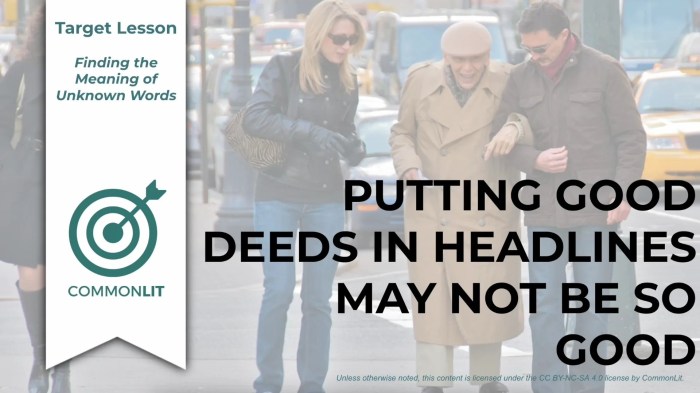Putting good deeds in headlines may not be so good. While it may seem like a positive way to attract readers, it can actually have several negative consequences. This article explores the effects of using “good deeds” in headlines, provides guidelines for balancing positive and negative headlines, and suggests alternative headline approaches that convey positive messages without resorting to sensationalism or manipulation.
Effects of Using “Good Deeds” in Headlines

Incorporating “good deeds” into headlines can significantly impact reader engagement. Positive headlines often attract attention and evoke positive emotions, leading to increased click-through rates and dwell time. However, using such headlines can also have potential negative consequences.
When headlines overemphasize or sensationalize good deeds, they can undermine the credibility of the article and lead to reader skepticism. Moreover, headlines that focus solely on positive aspects may fail to accurately represent the content, potentially misleading readers.
Examples of Effective and Ineffective Headlines
- Effective:“Local Hero Saves Dog from House Fire” (accurately conveys a positive deed without sensationalism)
- Ineffective:“Miracle on Main Street: Dog Rescued from Inferno” (overly dramatic and potentially misleading)
Balancing Positive and Negative Headlines

To avoid sensationalism, it is crucial to balance positive and negative headlines. Headlines should accurately reflect the content of the article, even if it includes negative aspects. This balance helps maintain credibility and trust with readers.
Ethical considerations also play a role in crafting headlines that involve good deeds. It is important to avoid exploiting or manipulating readers’ emotions for sensationalist purposes. Headlines should be respectful and avoid exploiting vulnerable populations.
Alternative Headline Approaches
There are alternative approaches to crafting headlines that convey positive messages without using “good deeds.” These approaches can help avoid potential pitfalls and create more engaging and informative headlines.
Using humor, anecdotes, or personal stories in headlines can be effective in capturing readers’ attention while also conveying a positive message. Headlines that focus on the impact or outcome of good deeds can also be effective.
Examples of Creative and Engaging Headlines, Putting good deeds in headlines may not be so good
- Humorous:“Heroic Doggo’s Day Out: Rescues Cat from Tree, Gets Free Belly Rubs” (uses humor to convey a positive deed)
- Anecdotal:“From Tragedy to Triumph: How a Single Act of Kindness Changed a Life” (uses a personal story to convey a positive message)
- Impact-Focused:“Small Act, Big Impact: Community Rallies to Rebuild Home for Fire Victims” (focuses on the positive impact of a good deed)
Impact on Content Perception: Putting Good Deeds In Headlines May Not Be So Good

Headlines can significantly shape readers’ perceptions of the content that follows. Misleading or overpromising headlines can lead to reader disappointment and decreased trust. Headlines should accurately reflect the tone and substance of the article.
Headlines that exaggerate or sensationalize good deeds can create unrealistic expectations and undermine the credibility of the content. It is important to avoid headlines that make claims that the article cannot support.
Best Practices for Ethical Headlines

To create ethical headlines, it is important to avoid manipulation or exploitation. Headlines should be transparent and authentic, accurately representing the content of the article.
Editors and publishers have a responsibility to ensure that headlines are responsible and ethical. They should provide guidance to writers and ensure that headlines adhere to ethical standards.
Guidelines for Ethical Headlines
- Avoid sensationalism and exaggerated claims.
- Accurately represent the content of the article.
- Respect readers’ emotions and avoid exploiting vulnerable populations.
- Use humor, anecdotes, or personal stories responsibly.
- Ensure transparency and authenticity.
FAQ Section
Why should we avoid using “good deeds” in headlines?
Using “good deeds” in headlines can lead to sensationalism, overpromising, and misleading readers about the content of the article.
How can we balance positive and negative headlines?
To avoid sensationalism, headlines should accurately represent the content of the article, balancing positive and negative aspects to provide a nuanced and informative overview.
What are some alternative approaches to crafting headlines that convey positive messages?
Alternative approaches include using humor, anecdotes, personal stories, or focusing on the impact or significance of the good deeds.